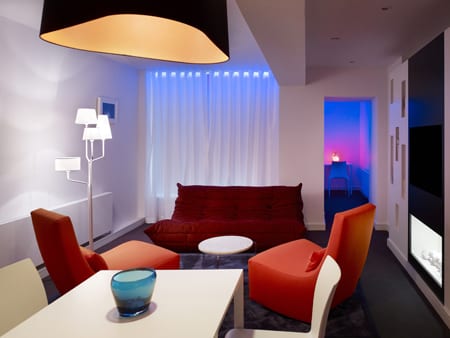Hospitality Design (HD) magazine and Culintro, a culinary trade organization in New York that brings together restaurant professionals, have teamed up to bring a monthly online Q&A with some of the nation’s top restaurant designers. Each month, we will feature a Q&A with an industry leader, talking about his/her newest project, the industry, what works, and what’s next.
 Fadi Riscala and Michelle Agnese
Fadi Riscala and Michelle Agnese
Principals
Riscala Agnese
New York
From overall concept and graphics to website design and interiors, New York designers Fadi Riscala and Michelle Agnese like to leave their mark on every aspect of their restaurants. Their designs mix playful elements like a mechanical bull in Rockefeller Center and splashes of vibrant red in New Jersey with sophisticated sensibilities that create the perfect backdrop to whatever the menu of the moment calls for. Riscala, who emigrated from Beirut in 1983, received a degree in interior design from Kean University Design School. He started his career with Q5 and was approached in ’96 to independently design his first restaurant, introducing Riscala Design as a professional design firm. Now with the addition of partner Michelle Agnese, Riscala Agnese Design Group creates some of the most imaginative spaces, sometimes on a shoestring budget, and sometimes helping neophyte restaurateurs from concept to completion. Here, the restaurant designers talk about their new Food Network series, the secret to a successful partnership, and advantages of being constantly curious.
 HD: What’s so great about designing restaurants?
HD: What’s so great about designing restaurants?
RA: By nature, designers are hungry for change, which can be an uncomfortable place. There is a constant call for fresh ideas and approaches in restaurant design, so it’s well within our comfort zone. What we’re saying is, we’re most comfortable being uncomfortable.
HD: You guys love to see a concept through…graphics, websites, menu design…why is it so important to you to get your hands on every aspect?
RA: The strength of any brand or concept comes from the continuity and consistency of its message. Restaurants are no exception. It is all about an overall statement, coming from one single breath. If we could be the chefs preparing the food as well, we probably would. From a practical aspect, limiting the number of parties that are involved in the overall process saves the client time and money.
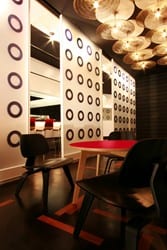 HD: Do you have a favorite place to start conceptualizing? (i.e., menu? location? building history?)
HD: Do you have a favorite place to start conceptualizing? (i.e., menu? location? building history?)
RA: We try to get to the root of our client’s intended concept by asking a lot of questions, to establish solid ground from which to start designing, rather than pulling from anything too obvious or superficial. Once we define the intended concept, the specific feel and level of design is driven by the target group and the budget.
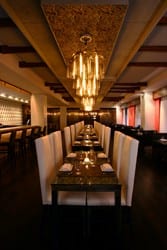 HD: How did you two come together?
HD: How did you two come together?
MA: A fabric rep told me about a guy who was designing restaurants out of a barn, but when I found him (in said barn), he didn’t have enough work to hire me. We clicked pretty instantly, so I kept showing up until he did.
FR: There was this persistent girl just out of college that kept showing up at my office until one day I had enough work to bring her on…her name was Michelle.
HD: What’s the secret to a great partnership?
FR: Embracing your differences and celebrating your similarities. As long as the similarities outweigh the differences!
MA: Respect for one another with no egos that get in the way is important to keep things moving in the right direction. But the natural dynamic between who we are as individuals enriches everything we do as a team. A common objective for the overall vision of our company and our projects is of utmost importance.
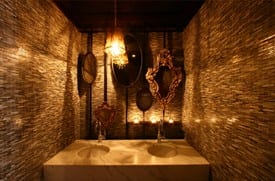 HD: What’s the secret to a great client relationship?
HD: What’s the secret to a great client relationship?
RA: Becoming truly part of the client’s team rather than just a ‘hired designer’; possessing a true sense of care and concern for the end result, putting your personal or professional interests aside, and working as an integral part of the collaboration, where the project benefits from each individual bringing something meaningful to the table.
HD: What was your big break?
FR: Being given the chance to design the very first restaurant, with not much of a portfolio to show and design fees that at the end of nine months averaged far below minimum wage. The feeling after the end result was exhilarating, and addicting.
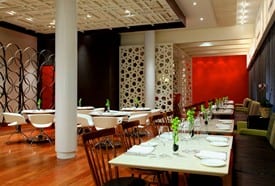 MA: What would probably be considered as a ‘big break’ by most is that we were recently hired to be the designers on a new Food Network series, Restaurant: Impossible. But after shooting two episodes, we realized that what was driving us was not the TV aspect of the show, but the design challenge at hand. For us, our brief involvement with the show offered more of a revelation than an actual ‘big break,’ returning to our own design world with a renewed sense of self, and a hunger to sink our teeth back into some serious restaurant projects. We have since connected with some really amazing people here in the city, and have many very exciting projects on the boards.
MA: What would probably be considered as a ‘big break’ by most is that we were recently hired to be the designers on a new Food Network series, Restaurant: Impossible. But after shooting two episodes, we realized that what was driving us was not the TV aspect of the show, but the design challenge at hand. For us, our brief involvement with the show offered more of a revelation than an actual ‘big break,’ returning to our own design world with a renewed sense of self, and a hunger to sink our teeth back into some serious restaurant projects. We have since connected with some really amazing people here in the city, and have many very exciting projects on the boards.
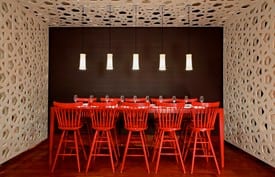 HD: What’s the most important thing to remember when designing a restaurant?
HD: What’s the most important thing to remember when designing a restaurant?
RA: The end user’s psychology (which is not necessarily that of the client), the timeline, and the budget.
HD: Restaurants you love for their design?
RA: Places with a singular thought carried through are definitely to be admired, like Thor. Craft for its understated class, Brasserie for its insightful modernism, and Buddakan for its dynamics.
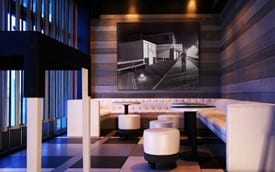 HD: Restaurants you love for their food?
HD: Restaurants you love for their food?
FR: That changes often; a recent good meal makes me forget the last, but most recently, Blue Ribbon.
MA: Right now, ABC Kitchen for its pure and natural goodness. Tabla, RIP.
HD: What projects are on the horizon?
RA: A collaboration with a client and architect from Southern France on a new Meatpacking District restaurant, a new blues joint in Philadelphia, the development of several new fast-casual concepts, and some exciting new hotel work.
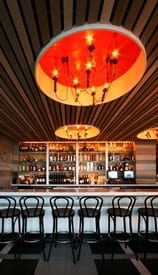 HD: Dream project?
HD: Dream project?
RA: Something not entirely real, more surreal, so our imagination is not limited by a specific practical use. Although, it would be really interesting to see how the public then uses whatever it is we create. In the real world: Stephen Starr’s next restaurant.
HD: Greatest lesson learned?
RA: Something that you learn quickly when you own your own design business is that the design industry is as much about ‘business’ as it is about ‘design.’ Not only for our own business, but also for that of our clients. On the other end, it’s not about what you know; it’s about what you’re willing to find out. Curiosity goes a long way in this business, or in any business for that matter. Design is problem solving, and to effectively remedy any problem, you have to really learn about where it originates.
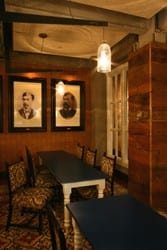 HD: Biggest challenges in the hospitality industry today?
HD: Biggest challenges in the hospitality industry today?
RA: Budgets and timelines have gotten significantly shorter with the shift in the economy, so we’ve had to adjust our services drastically to accommodate that. We are constantly stretching our minds to push the limits with materials and methods, in order to achieve the most possible, with less. Remaining interested in whatever capacity we are involved and executing many of the installations ourselves has been a huge benefit.
HD: Trend you are paying attention to?
RA: The trend of ‘avoiding trends’ yet to remain current. It’s a fine line. Trends in fine art and fashion have been influencing interiors, so that’s an interesting place to look for inspiration. An apparent trend has been places that are, or at least feel, ‘not designed.’ That’s a challenge for a designer, who wants to put a mark and a certain sophistication into a space. So we’re often having to find our place as designers, creating something that appears ‘not designed.’
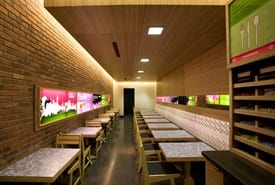 HD: When you are not at work, where can we find you?
HD: When you are not at work, where can we find you?
MA: Working somewhere else! We have a hard time ‘turning it off’…we do a lot of indirect research, strolling the sidewalks of New York, seeing what’s new, what’s old, what’s good (and what’s bad). We find a lot of inspiration throughout the city, always looking to mature our minds and our eyes. Beirut, Fadi’s hometown, is also a place that we visit when given the chance.
FR: Wherever Michelle is.
HD: What would your last meal be?
FR: I wasn’t aware this was my final hour! I would go back to my roots with homemade Labneh, olives, and pita.
MA: Since we’re dreaming, would have to be my late grandmother’s pasta, followed by her never-yet-matched chocolate cupcakes with ‘jimmies’…mmm.
Pictured from top left: Fadi Riscala and Michelle Agnese; Elements of Asia, Lawrenceville, New Jersey (two photos); Daryl Wine Bar, New Brunswick, New Jersey (two photos); uproot, Warren, New Jersey (two photos; photography by Sean Ranieri); the Boards, Asbury Park, New Jersey (two photos); Johnny Utah’s, New York City; Danku, New York City

